Community Perceptions of Coexistence with a River: The Case of Barrio Luján and the Ocloro River, Costa Rica
DOI:
https://doi.org/10.15359/rgac.69-2.13Keywords:
flood, city, perception, community, vulnerabilityAbstract
Barrio Luján is an urban community located in San José, Costa Rica, which has suffered for decades from floods that have been part of the history of people living there. For this reason, this research is focused on the one hand, on knowing the point of view of community residents on their coexistence with the Ocloro River, their opinions regarding that coexistence, and their perception about the existing civil organization to face this situation and, on the other hand, on inquiring about the state institutions that attend to them in the mentioned events.
References
Comité́ de Emergencias de Barrio Luján. (2017). [Calle inundada en barrio Luján]. Copia en posesión del autor.
Tecnológico de Costa Rica (TEC, 2014). Atlas de Costa Rica. Recuperado de: https://repositoriotec.tec.ac.cr/handle/2238/6749?show=full
Campos, M. (2017). Métodos de investigación académica. Fundamentos de la investigación bibliográfica. Versión 1.1. Universidad de Costa Rica. Sede de Occidente. Sistema de Educación General. Curso Integrado de Humanidades. Recuperado de: https://tinyurl.com/4a99376v
Cardona, O. (2001) Estimación holística del riesgo sísmico utilizando sistemas dinámicos complejos (Tesis doctoral). UPC, Departament d'Enginyeria del Terreny, Cartográfica. Recuperado de: https://www.tdx.cat/bitstream/handle/10803/6219/08Capitulo6.PDF
Desinventar. (2018). Sistema de inventarios de efectos de desastres. San José, Costa Rica. Recuperado de: https://www.desinventar.net/DesInventar/main.jsp
Ferrari, M. (2012). Análisis de vulnerabilidad y percepción social de las inundaciones en la ciudad de Trelew, Argentina. Cuadernos de Geografía. Revista Colombiana de Geografía 21(2) 99-116. doi: http://dx.doi.org/10.15446/rcdg.v21n2.32216
Gómez, C. (Junio de 2019). Aspectos Psicosociales. El camino hacia la resiliencia (Diapositivas de PowerPoint)
Instituto de Estudios Sociales en Población (IDESPO, 2019). Desplazados ambientales: nuevos procesos de exclusión y desigualdad en Costa Rica. Cod 0161-15. Enero 2016 - diciembre 2018. Sistema de Información Académica, SIA. Universidad Nacional.
Instituto Geográfico Nacional (2021). División político-administrativa de Costa Rica. Registro Nacional, San José, Costa Rica.
Jiménez, F., Faustino, J. & Velásquez, S. (s. f.). Análisis integral de la vulnerabilidad a amenazas naturales en cuencas hidrográficas de América Central. VI Semana Científica del CATIE.
Malavassi, R., & Vargas, V. (2010). Proyecto Barrios Costa Rica: Barrio Luján y Barrio México - San José, Costa Rica: Ministerio de Cultura y Juventud, Museo de Arte Costarricense: Imprenta GEDI, ICE. Recuperado de: https://issuu.com/valeriaarcesalazar/docs/pages
Maskrey, A., Cardona, O., García, V., Lavell, A., Macías, J. M., Romero, G. & Chaux, G. W. (1993). Los desastres no son naturales. Red de Estudios Sociales en Prevención de Desastres en América Latina. Recuperado de: https://www.desenredando.org/public/libros/1993/ldnsn/LosDesastresNoSonNaturales-1.0.0.pdf
Montero, S. & Salazar, V. (1991). Los desastres en Costa Rica: aspectos generales. San José, Costa Rica: Comisión Nacional de Emergencia.
Peralta, H. & Velásquez, A. (2017). Resiliencia. La clave del nuevo liderazgo del Siglo XXI. Colombia: Verónica Iglesias.
Pérez, D. (2017). Percepción y amenaza de inundaciones en Barrio Luján, San José (Requisito para optar al Diplomado en Cartografía y Diseño Digital). Universidad Nacional. Heredia, Costa Rica.
Solano, J. & Villalobos, A. (2017). Generalidades y registros climatológicos de las tormentas severas que han afectado la microcuenca del río Ocloro, en el Área Metropolitana de San José. 1967-2014. San José, Costa Rica: Ministerio del Ambiente y Energía.

Published
How to Cite
Issue
Section
License
Proposed policy for journals offering Open Access
Authors publishing their works in the Journal acknowledge and agree to the following terms:
a) Authors retain the copyrights to their works and guarantee the Journal the right to be the first to publish their works, under the Creative Commons License Attribution-NonCommercial-ShareAlike 4.0 International, CC BY-NC-SA 4.0 International (https://creativecommons.org/licenses/by-nc-sa/4.0/deed.es), which allows others to share works upon complying with the acknowledgment of authorship and mention of the Journal as the original publisher of the work.
b) Authors are permitted to separately establish additional agreements for the non-exclusive distribution of the official edition of the work published in the Journal (for example, authors may desire to place the work in an institutional repository or incorporate it into a book that is to published elsewhere) so long they acknowledgment to recognize the Journal as the original publisher. The aforementioned additional agreements must respect the terms of the non-profit character and sharing philosophy of the original license (CC BY-NC-SA 4.0 International, https://creativecommons.org/licenses/by-nc-sa/4.0/deed.es).
c) Authors are encouraged to archive the post-print or editor/PDF version in Open Access repositories.





 REVGEO is licensed under https://creativecommons.org/licenses/by-nc-sa/4.0/deed.es
REVGEO is licensed under https://creativecommons.org/licenses/by-nc-sa/4.0/deed.es
.svg_4.png)

_(1).png)
_(1)_(1)_(1)_1.png)
(2)(1)(1)(1).png)
